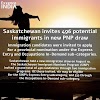Quebec has fallen even further behind the remainder of Canada in attracting immigrants, as the region's government stayed faithful to cut migration by 21 per cent in 2019.
According to data from Immigration, Outcasts and Citizenship Canada (IRCC), Quebec invited around 40,600 immigrants in 2019 contrasted with 51,100 the previous year.
Financial and family class confirmations dropped by 20 percent each while outcast class affirmations dropped by 17 percent.
In general, these figures speak to the most minimal affirmations of changeless inhabitants to the region since 2015. After winning force in October 2018, Head François Legault's government pledged to reduce migration.
The government said the reduction was important to ensure new debuts are properly integrated into Quebec's majority French-talking society and its work market.
According to data from Immigration, Outcasts and Citizenship Canada (IRCC), Quebec invited around 40,600 immigrants in 2019 contrasted with 51,100 the previous year.
Financial and family class confirmations dropped by 20 percent each while outcast class affirmations dropped by 17 percent.
In general, these figures speak to the most minimal affirmations of changeless inhabitants to the region since 2015. After winning force in October 2018, Head François Legault's government pledged to reduce migration.
The government said the reduction was important to ensure new debuts are properly integrated into Quebec's majority French-talking society and its work market.
 |
| exxence india |
Quebec resists the national trend
Quebec's choice to diminish migration remains as a glaring difference to the remainder of Canada. At the national level, Canada expanded its immigrant admission by 6 percent to 341,000 of every 2019.
Every one of the four territories in Atlantic Canada—Newfoundland and Labrador, prince Edward Island, New Brunswick, and Nova Scotia—delighted in a development pace of in any event 15 percent compared with 2018.
Ontario (12 percent), Manitoba (24 percent), Saskatchewan (2 percent), Alberta (4 percent), and British Columbia (12 percent), and Yukon (31 percent) likewise observed their immigrant admissions rise.
Migration across Canada should keep on becoming pushing ahead as the government targets more elevated levels of affirmations under its 2019-2021 migration Levels Plan.
21 per cent decline in immigration comes at a bad time
Quebec has probably the most established populace in Canada and its introduction to the world rate is similarly as low as the national normal. Consequently, the region quite essentially more significant levels of immigration to support its economy.
In the event that it supports low degrees of immigration moving forward, Quebec will compel its financial development potential.
In addition, it may become a less attractive destination for businesses to invest in. The private sector needs access to enough workers and consumers for it to invest in a jurisdiction. However, if Quebec keeps its immigration levels low, while other provinces such as Ontario are enjoying higher economic growth rates in large part due to immigration, then the private sector may opt to invest elsewhere.
Quebec would need to twofold its immigration admission to more than 80,000 newcomers yearly so as to keep pace with Canada's newcomer consumption on a for each capita premise (0.9 percent).
Following its significant reduction in 2019, Quebec now has the second-lowest per capita intake among Canada’s ten provinces, as it welcomed just 0.5 per cent of its population in newcomers, only ranking ahead of Newfoundland and Labrador (which had a per capita intake of 0.4 per cent).
Quebec plans to bring migration limits up in 2020
In October 2019, the Quebec government declared in its immigration plan that it would focus up to 44,500 newcomers in 2020. The method of reasoning for the higher objective is to help lighten work deficiencies in the territory.
So as to handle the work deficiencies, business gatherings, for example, The Office of Trade of Metropolitan Montreal and the Quebec Chamber of Bosses have been pushing for the government to increase immigration to 60,000 per year.
While 60,000 remains a far cry from the immigration levels that the province actually needs to sustain healthy levels of economic growth moving forward, it would still represent a significant improvement from the province’s current target.
Quebec right now has the second-most minimal joblessness rate among every single Canadian area, and its joblessness rate is truly low. It as of now remains at 5.1 percent, behind just English Columbia's joblessness pace of 4.5 percent. This is a solid pointer that Quebec can profit by more work—including by taking advantage of under-used wellsprings of ability inside Quebec, for example, people with handicaps, just as pulling in more Canadians and immigrants to the province.
For the time being, Quebec stays open to immigrants who wish to move there, but space is limited.
In 2020, almost 60 percent of the potential 44,500 new immigrants that could be conceded by the area are relied upon to come through economic immigration programs, for example, the Quebec skilled Laborer Program and the Quebec Experience Program.















0 Comments